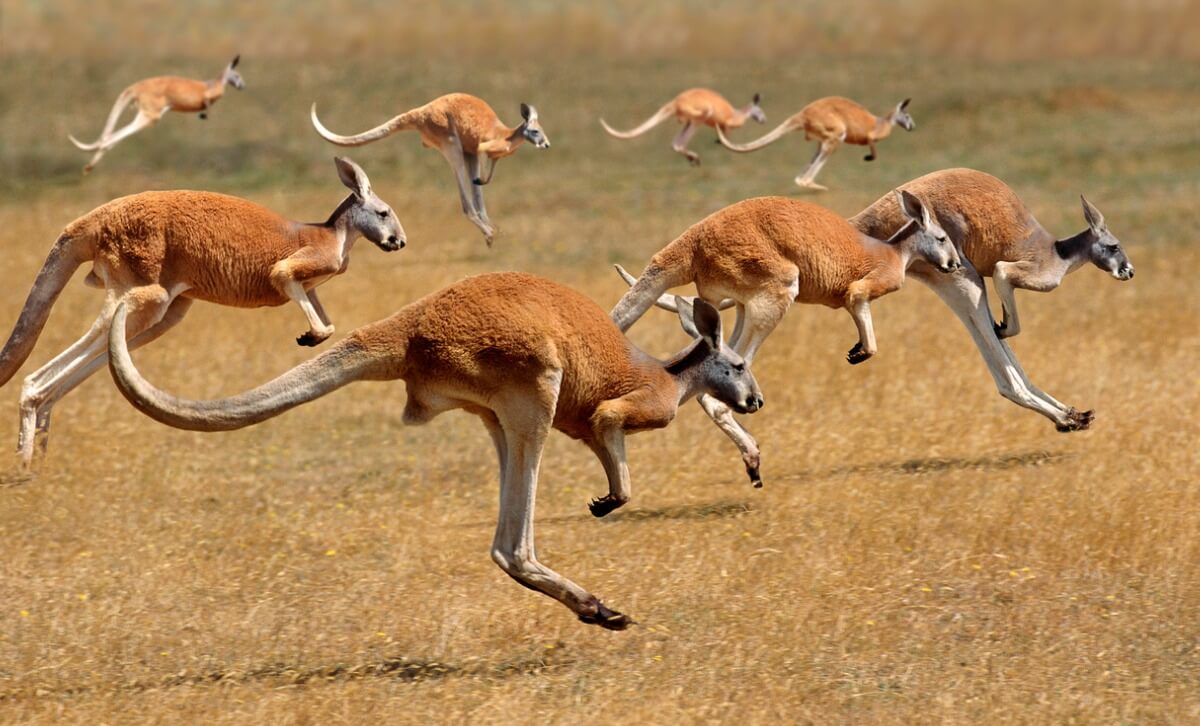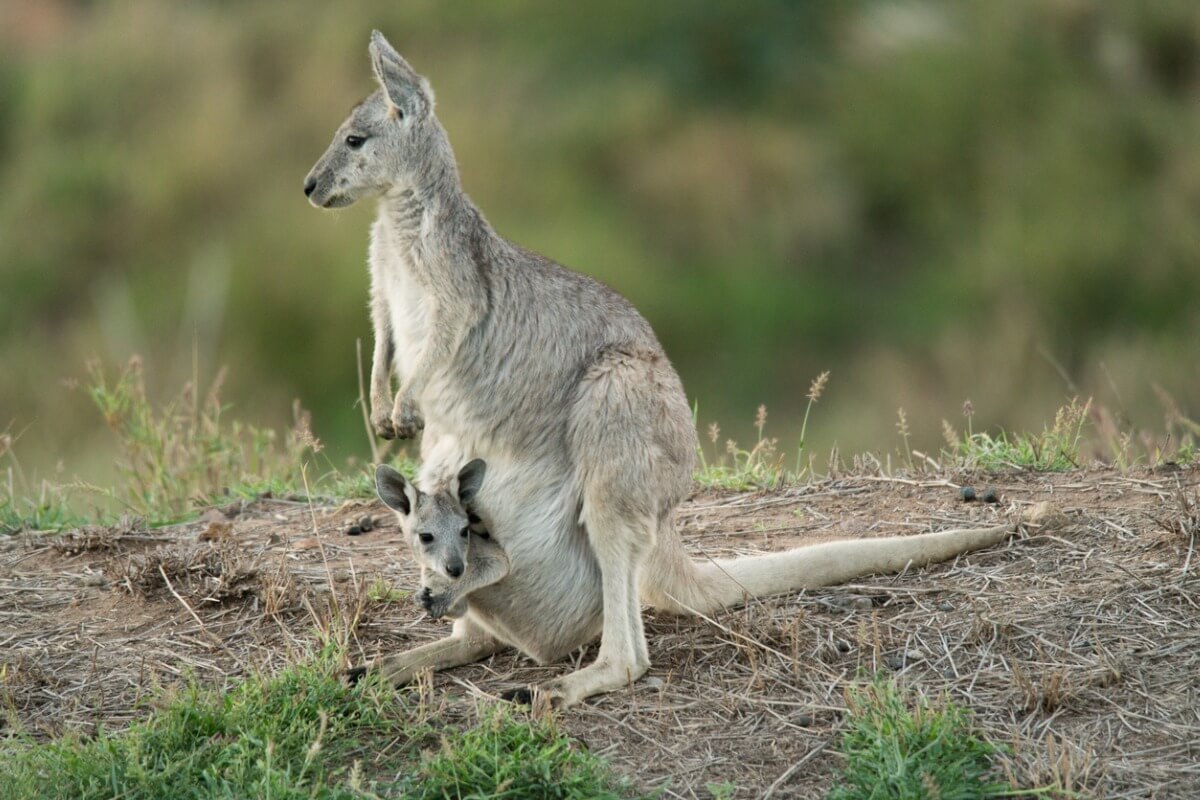Why and When Do Kangaroos Attack?

Kangaroos are very common animals in Australia. However, they’re also very well known to people around the world, who enjoy them in zoos or through videos or documentaries, but how much do we know about them and their social behavior? Are they aggressive mammals? And, if so, when and why do kangaroos attack?
They’re included in the family Macropodidae, along with wallabies and other related species. It’s common to consider the larger animals in this group to be kangaroos, but the term isn’t taxonomic in nature.
They’re generally non-aggressive animals. However, in certain circumstances, fights between them can be observed, and they may even attack humans. Keep reading as we detail the most important aspects of the characteristics and behavior of these animals, with emphasis how and why they can become aggressive.
Kangaroos’ characteristics

As we’ve already explained, the main characteristic of kangaroos is how large they are. They are more than one and a half meters in height (5 feet) and 90 kilograms (200 pounds) in weight. They’re the largest animals in the Macropodidae group and even among the marsupials.
Regarding their appearance, their powerful and elongated legs stand out, giving them the ability to make amazing jumps. In addition, they have a long tail. They also have a uniform coat, with a gray or brown coloration.
Despite their large size and their muscular, strong bodies, they’re herbivorous organisms, with a diet based on grasses and other plants. For this purpose, they have sharp teeth that allow them to easily bite these types of plants. They’re nocturnal and crepuscular animals that like to live in small groups.
Kangaroos are marsupials, which means that they have a pouch or marsupium in which their young develop.
Are kangaroos aggressive?
In general terms, these marsupials are calm animals. However, agonistic or aggressive behavior is well-documented under certain circumstances. This behavior includes fights between males. These fights may occur during the breeding season, in a struggle to mate with females or to maintain dominance.
Likewise, if they feel threatened, they may attack other animals.
How do kangaroos attack?
The males face each other upright, hitting each other with their front legs. They aim for the torso, shoulders, and head. They also kick each other with their hind legs, while supporting themselves with their tails. In addition, they may try to scratch each other with their claws. Generally, this behavior is carried out until one of them gives up and runs away.
Why are kangaroos dangerous?
These animals are quite intimidating, just look at their size and build! Likewise, we mustn’t forget to mention their powerful hind legs with their incredible strength that allows them to make such big jumps.
According to data from the Animal Diversity Web, the red kangaroo species (Macropus rufus) can reach running speeds of 64 kilometers per hour. Likewise, they can make impressive jumps of up to 3 meters high (nearly 10 feet), figures that show just how strong these animals are.
The characteristics of kangaroos and the fact that they are wild animals, make us respect them, since they can become dangerous in some circumstances.
Causes why kangaroos attack
So, we’ve seen that these animals have powerful “weapons” that they can inflict damage with if they want to. And there are several reasons why they might attack:
- They attack other kangaroos for dominance and to conquer females.
- They may attack other animals if they feel threatened by predation. Dogs are one such animal.
- These marsupials will attack humans if they feel threatened. If they perceive that humans may become a potential rival or perhaps a predator, they won’t hesitate to attack and defend themselves. Especially if they feel they have no other option or escape route.
- In cases where kangaroos are kept as exotic pets, the males may behave aggressively towards their owner, as a practice for when they’ll have to fight hand-to-hand with another member of their own species. As they grow older, these training attacks become stronger, making them more dangerous as well.
It is important to realize that kangaroos are wild animals that haven’t been domesticated, so they shouldn’t be kept as pets. Although they may seem cute when they’re small, they grow into a powerful animal that will attack if it feels in danger.
Kangaroo attacks on humans

Although kangaroo attacks on humans are rare, we aren’t exempt from them. The upright posture of human males can be perceived as a threatening position to male kangaroos, who attack when they feel intimidated.
In fact, incidents are so rare that there are fewer than 5 per year in New South Wales. The ABC News reported a fatal attack by a kangaroo on a 77-year-old man near Albany, Great Southern State, in September 2022. According to the source, the victim kept the animal as a pet. The article states that before this event there hadn’t been any fatal attacks in Australia since 1936.
As you can see, kangaroos attack for different reasons. Although they may seem harmless, the fact of the matter is that they are wild animals that shouldn’t be approached too closely. They won’t hesitate to attack if they feel threatened. It’s best not to be overconfident and enjoy these amazing creatures while keeping a prudent distance to ensure your safety.
All cited sources were thoroughly reviewed by our team to ensure their quality, reliability, currency, and validity. The bibliography of this article was considered reliable and of academic or scientific accuracy.
- Dewey, T., & Yue, M. (2001). Macropus rufus. Animal Diversity Web. Revisado el 25 de febrero de 2023, disponible en: https://animaldiversity.org/accounts/Macropus_rufus/
- Fiore, B., Bennet, M., & Couch, A. (2022). Kangaroo attack leaves 77-year-old alpaca breeder dead near Albany in WA’s Great Southern. ABC News. Revisado el 27 de febrero de 2023, disponible en: https://www.abc.net.au/news/2022-09-13/suspected-kangaroo-attack-leaves-man-dead-near-albany-in-wa/101432566
- Fundación Botánica y Zoológica de Barranquilla. Macrópodos. La familia de los canguros. Planeta Zoo, 2(6), 14-15. Disponible en: http://www.zoobaq.org/planetazoo/pdf/Planeta%20Zoo-06.pdf
- Office of Environment & Heritage NSW. (2011). Living with kangaroos. Revisado el 26 de febrero de 2023, disponible en: https://www.environment.nsw.gov.au/-/media/OEH/Corporate-Site/Documents/Animals-and-plants/Native-animals/living-with-kangaroos-100968.pdf
- Russell, E. (1974). The biology of kangaroos (Marsupialia-Macropodidae). Mammal Review, 4(1-2), 1-59. Disponible en: https://onlinelibrary.wiley.com/doi/10.1111/j.1365-2907.1974.tb00347.x
This text is provided for informational purposes only and does not replace consultation with a professional. If in doubt, consult your specialist.